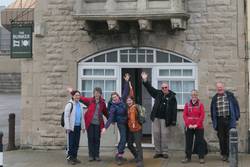Our May Bank Holiday trip was to the exotic Isle of Portland in Dorset, staying in The Bunker, a lovely independent hostel on Victoria Square.
Victoria Square was probably in its heyday in the late Victorian period when, in 1862, a railway branch line was constructed linking Portland to Weymouth. The opening of the railway fueled a demand for accommodation and the Terminus Hotel opened in 1867. It’s still there today, only now known as The Little Ship.
With all this civic prosperity what they needed was a club for the local captains of industry. The original Masonic Hall was opened in 1879. The building was clearly constructed with a lot of pride, the frontage covered in stone carvings by a Mr Grassby. Interestingly, Grassby Monumental Masons of Dorchester are still going strong over 100 years later. By contrast, the bigger Masonic Hall that replaced it in 1899 was a much more utilitarian box. This clearly worked, as it’s still in use today, whereas the original ‘fancy’ masonic hall is now The Bunker, home for CYHA for the Bank Holiday weekend.
In the dining room we could see masonic symbols over the fireplace. As well as the classic square and compasses, there was a Star of David panel, a link to King Solomon who was rumoured to be one of the first Masons. The third panel appeared to be the Senior and Junior Warden symbols. The Senior Warden is based on a stone mason’s level and the Junior Warden is essentially a plumb weight. Apparently, these symbolise level and upright behaviour, so perfectly in keeping with CYHA.
So what brought on all this prosperity? For centuries the creamy Portland limestone had been used to build magnificent buildings all over the country. Think The Palace of Westminster (1347), The Tower of London (1349) and parts of Buckingham Palace (1854) for starters. The coming of the railway helped transport the stone more efficiently. Before that cranes were used to lower blocks on to waiting ships. When we walked round the island, we saw a couple of the old cranes still in situ. Certainly, we were slogging up some of the old inclines they used to use to move the vast blocks. Ali
Life’s a Beach
On a visit to Portland you can’t miss the massive shingle bank that is Chesil Beach. I remember studying it in school geography, but nothing quite prepares you for the scale of it. From Victoria Square you could see it towering above the buildings across the street. It looked a bit threatening, but it was protecting them from the winter storms.
The beach started as sandy deposits in Lyme Bay at the end of the ice age 20,000-14,000 years ago. Over time, longshore drift pushed the gravels eastwards, sorting the pebbles by size. Even now it’s estimated to move east at a rate of about 15cm per year.
Rising water levels caused some over-topping of the Chesil barrier beach and the area of water called The Fleet was formed. This area along with the shingle itself forms a unique habitat and it the reason for the Chesil and Fleet Nature Reserve – and their rather excellent café.
Welcome to Sue & Jacqueline
The Portland trip was also the first trip for new members Sue and Jacqueline. In a bold move, they volunteered for a dinner and pudding a-piece.
Sue’s curry and Jacqueline’s almond tart ticked the boxes for both deliciousness and availability of seconds.
They can definitely come again!
Portland Memories:
- Cress: “lift your leg up and I’ll pull it off” to Doug trying to remove his zip-offs.

